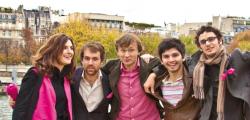
Romanians folk dance troupe 2018. Photo by Joe Mabel – Wikimedia commons
10 Romanian Traditions you should know about
Romania is believed to be a land of myth and legend. The Romanian people derive much of their ethnic and cultural character from the Roman influence. They regarded themselves as the descendants of the ancient Romans. These Romans conquered the southern Transylvania under the emperor Trajan and the Dacian who lived in the mountains of the Danuban plain.
The Romanian people are the most friendly and hospitable on earth. There are several traditions that are still present in Romanians’ daily life. From rain-making to leaving gifts by the window for fate fairies. Some of Romania’s traditions that you should be aware of them include as following;
1. Dream of the future husband on Boboteza
Romanian married women are said to see their future husbands in their dream before the holiday night of Epiphany/ Boboteza. They are normally advised to put a small branch of dried basil under their pillow. The small branch of dried basil should and must be received from a priest. The ritual is normally performed before the holiday of the Sanziene, the good fairies of summer.
2. Sanziene

Sanziene festivals 2013. Photo by Saturnian –Wikimedia commons
It is similar to the Swedish midsummer holiday. Sanziene is usually celebrated on 24 June. It marks the summer solstice. The tradition involves young women who dress in long white dresses and wear beautiful crowns. They are made of wildflowers and wheatears in their hair. The central point of the ritual is their dance which usually takes place in the evening around a bonfire. Sanziene is considered to be a magical night when fairies dance in the forest of Romania and the gate of heaven opens. In the last years, it became a symbol of a beautiful Romanian blouse
3. Eating garlic on St Andrew’s Day
On 30th November which is St Andrew’s day is a popular custom to take a handful of wheat and place it on a sunny spot in the house. When the wheat grows tall and healthy it means that the coming year will be a happy one. There is also a common belief in Romanian that says on this night evil spirits and creatures like werewolves and strigoi get free reign and can enter people’s homes. The only best way to keep these devil creatures away is by eating garlic and decorating the house with it.
4. Romania’s traditional clothing

Romanian Winter Tradition.Photo by Alecsandra – Wikimedia commons
Traditionally clothing of the Romanian people can be described as handmade clothing. Its origin is from the ancient Dacian civilization. A white shirt or blouse made from linen or wool is the basic garment for both men and women in Romania Traditional dress varies based on where you live in Romania. Color, materials, and patterns are used for traditional dresses. Traditional clothing varies widely in Romania.
5. Traditional dancing
Dancing and music are a large part of visiting Romania. Think line dancing, barn dancing, and square dancing are some traditional dances done in Romania. Young people seem to be very enthusiastic and confident about dancing. Many towns have local dance groups that teach young people of all ages traditional dances.
6. Embroidery

Children’s costume embroidery. Photo by Vujoic – Wikimedia commons
The textile of Romania features embroidery. They are very ornate and delicate. The patterns, colours, and materials denote where you are from in Romania. The Romanians can tell where you live by the clothes you are wearing. The patterns normally tell a story and are symbols from the local area. They are passed down from generation to generation. Many patterns can be found in the pottery and painted eggs.
7. Easter eggs competitions

A traditional way to celebrate Easter. Photo by Jan Kamenick –Wikimedia commons
Easter is one of the most important public holidays in Romania. They celebrate the resurrections of Jesus which is the most important. Painted eggs are always present on the table during the holiday. They are one of the main symbols of Orthodox Easter in Romania. The coloured eggs are the heart of the fun competition that lasts 3 days on Easter
The tradition says that people who knock on the painted eggs on the first day of Easter will see each other after. According to Romania, the first person who taps the egg says ”Christ has resurrected’ while the second person goes on saying’ ‘indeed he has resurrected. The belief is that the person whose eggs are unbroken will enjoy the most extended life.
8. Traditional greeting of bread and salt
The traditional treating of bread and salt symbolises hospitality and welcome to guests at their homes in Romania. Traditionally bread is an ancient symbol of life and salt is a highly prized element. They are symbols of welcome and hospitality. When offered take a small piece of bread and dip it in the salt and then eat. To refuse the welcome is an act of rudeness. In the ritual, bread signifies food and salt is the flavour of food. It is a highly valued commodity signifying the importance of guests in their homes.
9. The kidnapping of the bride

Wedding march. Photo by Thaler Thamas – Wikimedia commons
Modern tradition weddings are witnessed every summer weekend in Romania. When visiting the most beautiful place in Romania it is not uncommon to see a runaway bride. Since the bride has been kidnapped and held for ransom. The custom dictates that at some point the groom doesn’t pay attention to friends, and the family from the party kidnap the bride. They only agree to take her back to the party when the groom realizes and agreed to pay for her return. The price normally has a symbolic and has a bit of fun.
10 . Pig slaughter for Christmas
The slaughtering of pigs is still carried out in many households around the Christmas period. The activity normally involves the adult males who kill the animal and get to cut it into pieces. While the women cook after the meat has been processed. A slice cut from the pig’s forehead is the first thing to eat. During the ritual, nothing is discarded. Including the blood which is collected and used to prepare traditional dishes like sangrete/ blood sausages. The pig’s hoofs were used to make buttons. while the hair is collected to make toothbrushes and brushes.
Planning a trip to Paris ? Get ready !
These are Amazon’s best-selling travel products that you may need for coming to Paris.
Bookstore
- The best travel book : Rick Steves – Paris 2023 – Learn more here
- Fodor’s Paris 2024 – Learn more here
Travel Gear
- Venture Pal Lightweight Backpack – Learn more here
- Samsonite Winfield 2 28″ Luggage – Learn more here
- Swig Savvy’s Stainless Steel Insulated Water Bottle – Learn more here
Check Amazon’s best-seller list for the most popular travel accessories. We sometimes read this list just to find out what new travel products people are buying.










